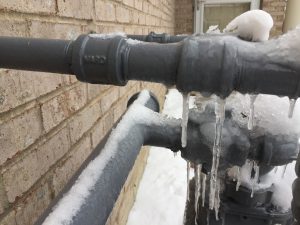What're your concepts about Preventing and dealing with frozen pipes?

Winter can damage your plumbing, particularly by freezing pipelines. Below's exactly how to prevent it from happening and what to do if it does.
Intro
As temperatures drop, the threat of frozen pipelines boosts, potentially bring about expensive repair work and water damages. Comprehending just how to avoid icy pipes is crucial for house owners in cool climates.
Prevention Tips
Insulating prone pipelines
Cover pipelines in insulation sleeves or make use of warmth tape to protect them from freezing temperatures. Focus on pipes in unheated or exterior areas of the home.
Home heating strategies
Maintain indoor rooms adequately heated, specifically locations with pipes. Open closet doors to permit cozy air to distribute around pipelines under sinks.
Just how to determine icy pipelines
Try to find decreased water flow from taps, uncommon smells or noises from pipes, and noticeable frost on subjected pipelines.
Long-Term Solutions
Architectural adjustments
Think about rerouting pipelines far from outside walls or unheated areas. Add additional insulation to attics, basements, and crawl spaces.
Upgrading insulation
Purchase high-grade insulation for pipelines, attic rooms, and wall surfaces. Appropriate insulation assists preserve consistent temperatures and reduces the threat of icy pipelines.
Safeguarding Outdoor Plumbing
Yard pipes and outdoor taps
Separate and drain garden pipes before winter. Mount frost-proof spigots or cover exterior taps with insulated caps.
Recognizing Frozen Pipelines
What causes pipelines to freeze?
Pipelines freeze when subjected to temperatures below 32 ° F (0 ° C) for expanded periods. As water inside the pipelines ices up, it broadens, putting pressure on the pipe walls and potentially causing them to break.
Threats and problems
Frozen pipes can result in supply of water disruptions, residential property damage, and expensive repairs. Ruptured pipes can flood homes and create substantial structural damage.
Signs of Frozen Pipes
Recognizing frozen pipelines early can avoid them from breaking.
What to Do If Your Pipes Freeze
Immediate activities to take
If you think frozen pipelines, maintain taps open to eliminate stress as the ice thaws. Use a hairdryer or towels soaked in hot water to thaw pipes gradually.
Verdict
Stopping frozen pipelines requires aggressive procedures and quick responses. By recognizing the causes, indicators, and preventive measures, house owners can protect their plumbing throughout winter.
5 Ways to Prevent Frozen Pipes
Drain Outdoor Faucets and Disconnect Hoses
First, close the shut-off valve that controls the flow of water in the pipe to your outdoor faucet. Then, head outside to disconnect and drain your hose and open the outdoor faucet to allow the water to completely drain out of the line. Turn off the faucet when done. Finally, head back to the shut-off valve and drain the remaining water inside the pipe into a bucket or container. Additionally, if you have a home irrigation system, you should consider hiring an expert to clear the system of water each year.
Insulate Pipes
One of the best and most cost-effective methods for preventing frozen water pipes is to wrap your pipes with insulation. This is especially important for areas in your home that aren’t exposed to heat, such as an attic. We suggest using foam sleeves, which can typically be found at your local hardware store.
Keep Heat Running at 65
Your pipes are located inside your walls, and the temperature there is much colder than the rest of the house. To prevent your pipes from freezing, The Insurance Information Institute suggests that you keep your home heated to at least 65 degrees, even when traveling. You may want to invest in smart devices that can keep an eye on the temperature in your home while you’re away.
Leave Water Dripping
Moving water — even a small trickle — can prevent ice from forming inside your pipes. When freezing temps are imminent, start a drip of water from all faucets that serve exposed pipes. Leaving a few faucets running will also help relieve pressure inside the pipes and help prevent a rupture if the water inside freezes.
Open Cupboard Doors
Warm your kitchen and bathroom pipes by opening cupboards and vanities. You should also leave your interior doors ajar to help warm air circulate evenly throughout your home.

I am just very serious about Preventing and dealing with frozen pipes and I am hoping you enjoyed the entire blog post. In case you appreciated our post plz be sure to share it. I value reading our article about How to Prevent Your Pipes From Freezing.
Call Today